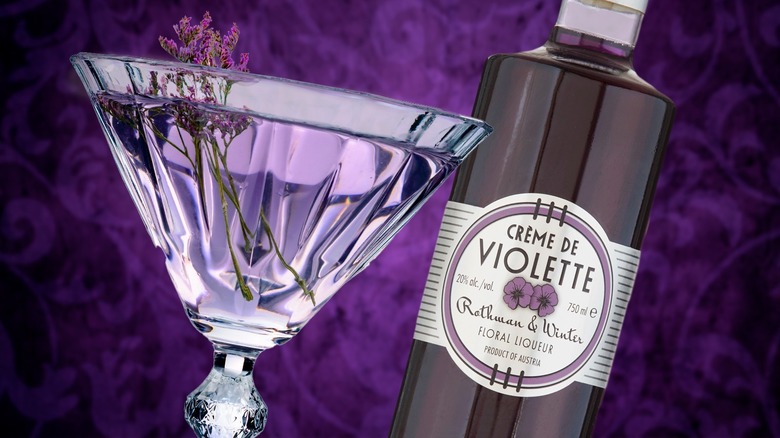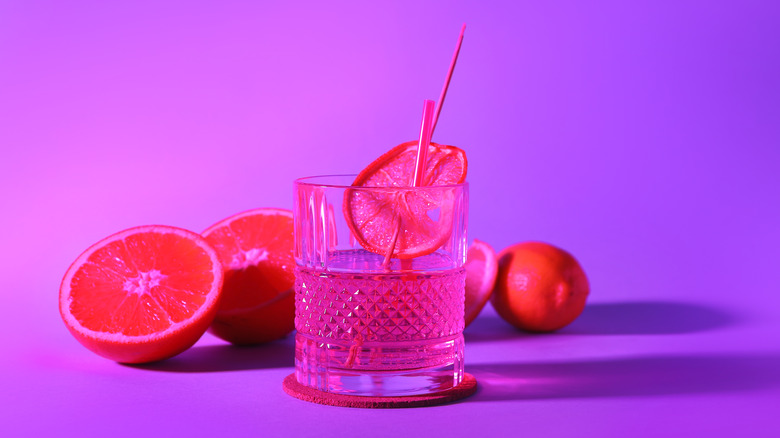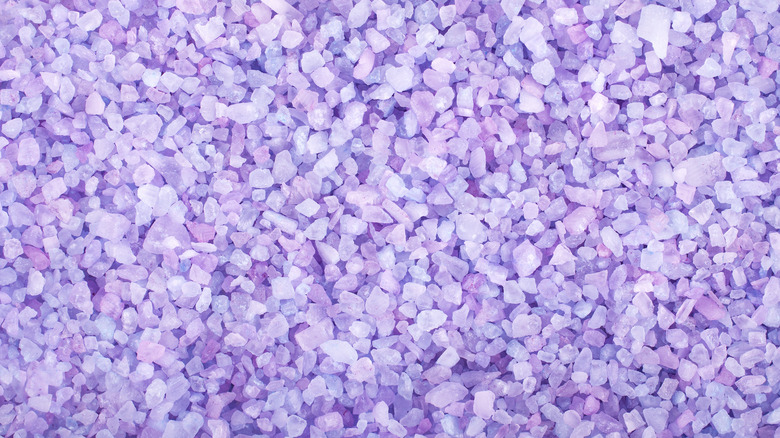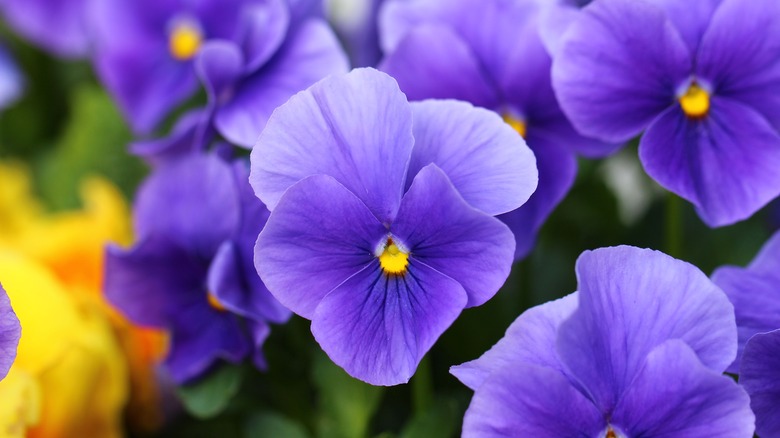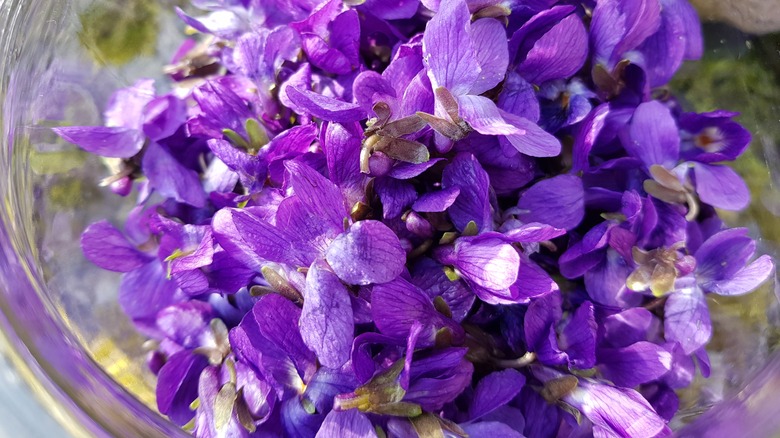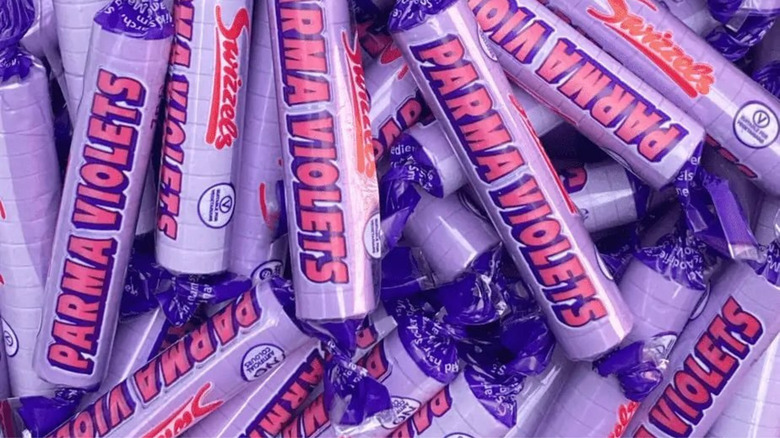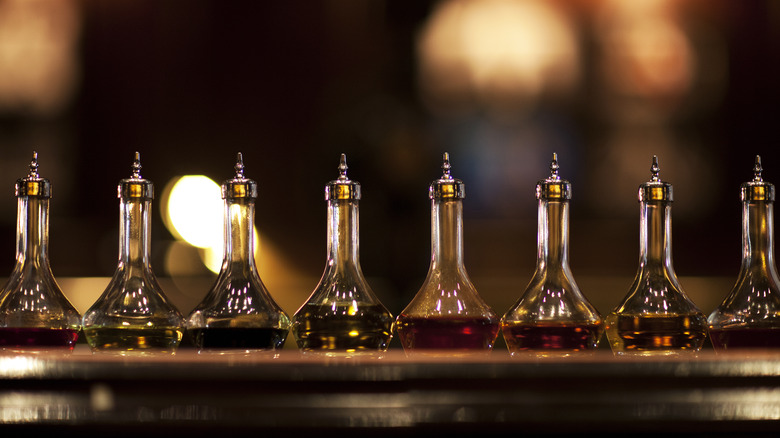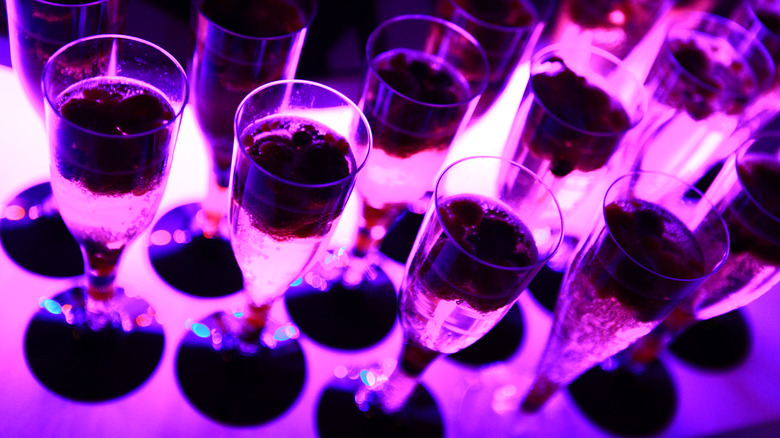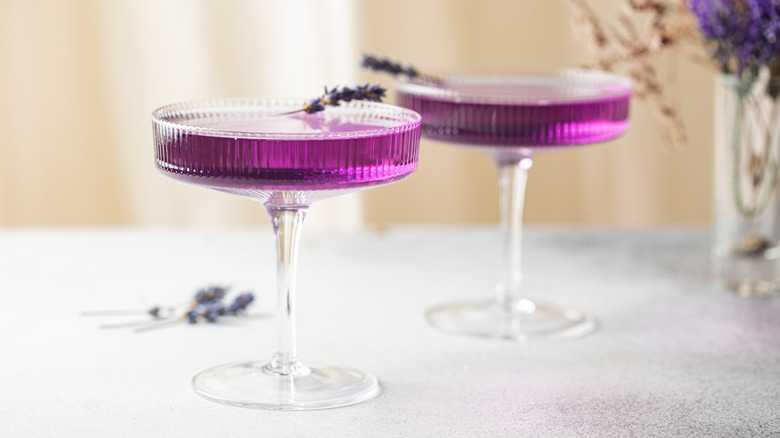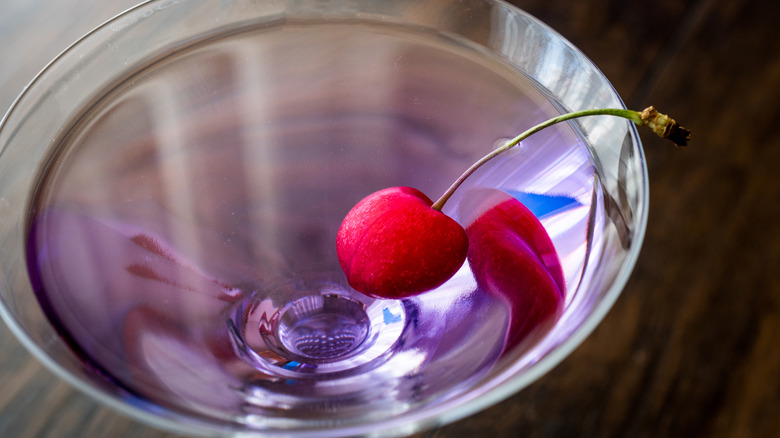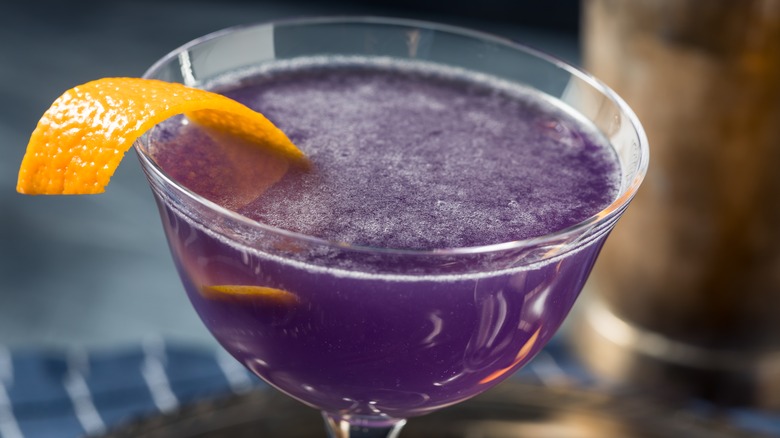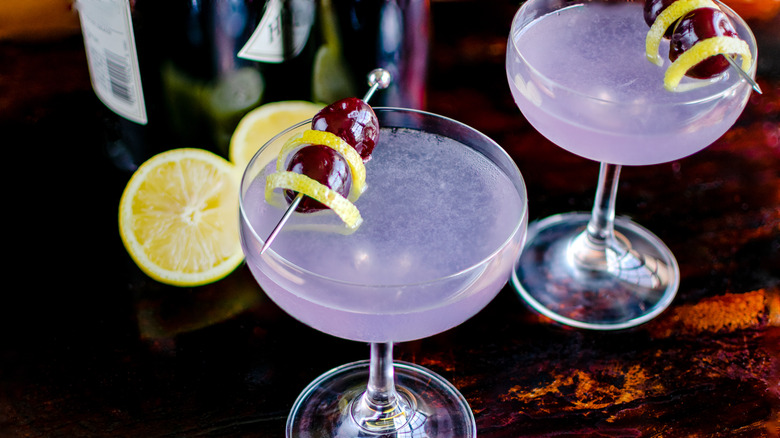11 Ways To Use Creme De Violette In Cocktails, According To An International Bartender
Creme de Violette is pretty unique as liqueurs go. With brandy or a neutral spirit for a base, the alcohol is then infused with violet flowers, giving it an extremely fragrant aroma and perfumed flavor.
It's definitely something of an acquired taste, with some folks finding it to be too floral and fragrant for their liking, and its potent and peculiar profile makes it a little trickier to work it into drinks. Unlike some cocktail ingredients, Creme de Violette won't go unnoticed if your recipe is a bit off. As a result, the bright purple beverage is one that you'll frequently find on a bar shelf gathering dust, bought either out of curiosity or a sense of bar shelf completionism.
I once took over management of a bar at an acclaimed restaurant in New Zealand and found a case of six bottles of Creme de Violette in the store room — I can only assume it was an ordering error and nobody knew how to shift the stuff. Either way, it had to go, and I didn't want to make a loss, so I had to get a little creative. The list below covers all of the tricks I pulled to create a variety of delicious drinks with Creme de Violette, all of which you can make work at home.
Make the colors pop
One of the first things you'll notice is its stunningly deep royal purple hue. Any experienced bartender will tell you how important presentation is when it comes to cocktail making, and that the first sip is taken with the eyes.
There are few colors more interesting than vivid violet, and there are a number of ways to add a pop of purple to your drink. It's not uncommon to combine blue curaçao with grenadine or cranberry juice to create purple cocktails, or to use the blackcurrant-flavored Creme de Cassis, but these have notably fruity tastes. If you're not after an overtly saccharine cocktail, these ingredients might not work out. However, Creme de Violet doesn't pose this issue, and while its floral flavoring won't work in every cocktail, it's perfect for adding a more delicate purple coloring to drinks.
You can also layer Creme de Violette in cocktails by making sure the liqueur is room temperature and pouring it slowly into your cocktail over the back of a bar spoon. Being somewhat viscous, with a steady hand the Creme de Violette should settle at the bottom of the glass creating a striking layering effect. Layering can take some practice to get right but it's a skill that's worth having if you want to experiment with more impressive presentation techniques.
Create your own violet salt
While most of us are probably familiar with salting the rim of a margarita glass, there are plenty of other interesting ways to use the common household seasoning with cocktails. When combined with bitter ingredients, salt enhances the perceived sweetness of a drink, and it's easier than you might think to create your own flavored salt at home.
The trickiest part of the process is getting your hands on a food dehydrator, although fortunately, these are relatively cheap to get hold of. In a dehydrator rack with a solid base, pour in a shallow layer of Creme de Violette. This is a recipe that takes some patience, as depending on how much liqueur you're using, it might take up to three days for the alcohol to evaporate and the remnants of the liquid to crystallize.
You may need to break up the forming crystals part way through the dehydrating process, but by the time you're finished, you should be left with a layer of residue that's similar in consistency to hard candies. Now, we need to combine our violet crystals with sea salt, and while you can do this in a bowl with the back of a spoon, a mortar and pestle is most effective. Add the sea salt to the violet crystals one pinch at a time, and grind the two together until they're fully combined and you're happy with the taste — it's as simple as that.
Focus on the aroma
If we take the first sip of a cocktail with our eyes, then we take the second with our nose. Before the glass touches our lips, we can sense the inviting aroma of a cocktail, and there's nothing to say this can only come from the drink's ingredients.
Creme de Violette is a potent liqueur, and you may want to take advantage of its enticing fragrance without the strong taste messing with the other cocktail ingredients and throwing the flavors out of balance. The solution is remarkably straightforward — just get yourself a miniature one-ounce spritz bottle and decant a little Creme de Violette into it with a funnel. Now you can give your cocktail a couple of sprays of Creme de Violette to imbue it with a perfumed aroma without having to add any directly to your drink. Even if you are using the liqueur as a liquid ingredient, a quick burst of Creme de Violette will elevate your cocktail's floral qualities.
This is a trick worth remembering because you can play around with all sorts of aromas, from peaty scotch mists to fruity citrus spritzes. To go even further, you can garnish your cocktail with fresh violet flower petals, either clipped to the rim of the glass or left to float atop the liquid as they're completely safe to consume.
Brew up a violet syrup
Out of all of the recipes ingrained in a bartender's mind, the handiest also happens to be the easiest. One part sugar dissolved in one part water produces simple syrup, a key ingredient responsible for adding a neutral sweetness and fatter texture to countless cocktails.
However, simple syrup doesn't have to be flavorless, and it doesn't take much extra effort to create a unique syrup with heaps of interesting characteristics. Most syrups can be made by infusing a standard simple syrup with other ingredients, reducing a liquid ingredient in a saucepan with added sugar, or a combination of the two. For a straightforward Creme de Violette syrup, you want to start by reducing the liqueur over medium heat, adding sugar to taste.
To make your syrup more complex, think about steeping other ingredients in the reduced liquid, such as citrus peel or even black peppercorns. Once you've made your syrup, you should only need a small amount to add a big burst of violet flavor to any of your drinks. If you feel like making a delicious drink with less fuss, you can add a splash of syrup to soda water or lemonade for an incredibly refreshing cocktail that takes mere seconds to prepare. Bear in mind that the shelf-life of homemade simple syrup can vary depending on the ingredients you use, a higher sugar content will extend its life, and there are tricks you can use to stabilize your syrup for even longer.
Recreate a favorite British childhood candy
If you crack open a bottle of Creme de Violette and hand it to a Brit, they'll almost certainly mention how it reminds them of Parma Violets. Named after a specific type of violet flower, these famous candies were once marketed as a perfumed breath freshener and continue to divide opinion with their soapy, floral flavor.
In fact, if you find a Brit who detests Creme de Violette, it's a sure bet they can't stand the traditional sweeties either. The fans, however, are often blown away when they realize a liqueur exists that tastes like Parma Violets and are usually eager to know how to recreate their childhood treat in the form of a boozy beverage. While there are no official recipes for a Parma Violet cocktail, that hasn't stopped folks from trying, and what the recipe should be is somewhat subjective.
A dry London gin or quality vodka is the best choice for a base spirit, with a liberal dose of Creme de Violette. You'll need a sugary component to emulate the candy-like characteristics, which is where your violet syrup might come in handy if simple syrup isn't hitting the spot. Lastly, you'll want to consider a citrus component that will cut through the intensely perfumed notes and the sugar, with lemon juice being a favorite. It's up to you whether you want to serve it straight up, over ice, or lengthened with soda or lemonade.
Make your own violet bitters
If you're unfamiliar with what bitters are and what they have to do with cocktails, the simple answer is that they're a flavored alcohol tincture that can transform a cocktail by adding depth and tying flavors together. There's a vast range of flavors to choose from but it's also pretty fun trying to create your own.
Some companies already sell violet-flavored bitters, including The Bitter Truth, a brand that made the cut in my ranking of the best bitters brands from around the world. These are a great option if you don't have the time to experiment with making bitters, but all it takes is a little time, patience, and a few interesting ingredients.
The base of our tincture should be a neutral-tasting spirit over 100 proof, like a strong vodka or a grain alcohol like Everclear. To make violet bitters, we can use one of these to fortify Creme de Violette to the extent that just a few drops are needed to enhance a cocktail. Then, you can decide which bittering ingredients you want to add and which other flavors you want to present. Citrus peel, licorice root, and wild cherry bark are just a few bittering agents that would work well, while there are plenty of spices, fruits, and herbs that can add complexity. Then, all you can do is wait, possibly up to a few weeks, until the flavors have completely melded together and you can strain out your finished bitters.
Try Creme de Violette with bubbles
The slightly sweet and abundantly floral nature of Creme de Violette means the liqueur pairs superbly with the effervescent elegance of sparkling wine. You don't even need a complicated recipe to boost your glass of bubbles — just add ¼ to ½ ounce of Creme de Violette to your wine of choice and give it a gentle stir.
The style of sparkling wine you choose is up to you, although it's worth noting that a brut Champagne is arguably the best pick. Its dry character will offset the sweetness of the Creme de Violette while its fruity and floral notes will interplay with the liqueur's similar qualities.
However, if you're after a more complex beverage with extra ingredients, an Italian prosecco is going to be a more suitable option. They're generally brighter and simpler wines, whereas the nuances of Champagne can be lost in mixed drinks. For starters, I'd suggest putting a twist on the classic French 75 cocktail which consists of sparkling wine, gin, lemon juice, and simple syrup, but swapping out the syrup for Creme de Violette. From here, you can start playing around with other recipes to find one that really hits the spot.
Put a twist on classics
We have a term in the bar industry that tends to draw puzzled looks from those not quite in the know — "potato-heading." The phrase refers to the famous children's toy, Mr. Potato Head, which lets you pull out and swap around the spud's limbs and facial features, and we can do the same thing with cocktails.
When you've been making cocktails for a while, you start to realize that some of the best contemporary drinks are just twists on classics. As long as the drink remains balanced, you can pull out ingredients and replace them with ones that complement or contrast the rest of the cocktail's components. Suppose you're relatively new to making cocktails. In that case, potato-heading is a great way to experiment with different ingredients without blasting through bottles trying to invent a new world-class cocktail from scratch. The costs start to add up after a while.
Creme de Violette is best used as a substitute for sweet, fruity, or floral ingredients as opposed to swapping it in for the base spirit. For example, in a margarita, you can use it in place of triple sec. You can also reduce the amount of simple syrup in a drink and replace it with Creme de Violette, something that works particularly well in gin-based drinks like gin fizzes, Tom Collins' and Brambles.
Take inspiration from the old school
Like most spirits and liqueurs, the history of Creme de Violette is a pretty interesting one. The specifics are hard to pin down, but we know it appeared in France sometime in the early 19th century.
Violet-flavored candies were all the rage at the time, as the flower had long been touted as a remedy for a range of ailments, including respiratory and pulmonary illnesses. Originally, the liqueur was consumed neat as an aperitif or mixed with fortified wine, but by the turn of the 20th century, the forebears of the modern cocktail movement began getting more creative with Creme de Violette.
One notable example worth recreating is the Arsenic & Old Lace, which was named after a 1939 play and combines Creme de Violette with gin, absinthe, and dry vermouth to create a martini-style drink bursting with floral and herbal notes. Likewise, the Blue Moon was purportedly invented in the 1940s by the same employee of Manhattan's Waldorf-Astoria hotel who's said to have invented both the Waldorf salad and eggs benedict. This is a beautifully frothy cocktail that deftly mixes Creme de Violette with London Dry gin, lemon juice, sugar syrup, and egg white to produce a floral sour-style drink that can sit as comfortably on a modern cocktail list as any contemporary creation.
Listen to the experts
Despite the surging popularity of Creme de Violette in the 20th century, Europe's largest producer folded in at some point in the sixties, and bottles became extremely hard to come by. As a result, the liqueur fell out of fashion until 2007, when drinks importer Haus Alpenz launched the Rothman & Winter brand and revived the original recipe.
It didn't take long before the best bartenders in the business took interest and began experimenting with Creme de Violette in their venues, and soon a new wave of violet-based cocktails began to hit the mainstream once more. One of the most famous iterations is arguably the Water Lily, invented by Richard Boccato, one of the modern era's most respected mixologists. Born in Italy, Boccato was an integral part of the New York Cocktail scene and created the Water Lily while working at NYC's infamous Milk & Honey bar. The measurements are simple to remember as everything's in equal parts, calling for ¾ ounce each of Creme de Violette, gin, orange liqueur, and lemon juice stirred over ice. A special mention also goes out to Death & Co's Phil Ward, another hero of the international bar scene and king of potato-heading, who adds a bittersweet grapefruit component to his Risk Pool cocktail.
Try the all-time favorite
Out of all the Creme de Violette-based cocktails, there's one that stands out as a true classic. Although the sky-blue Aviation now sits comfortably as one of 33 cocktails on the International Bartenders Association's official list, it's a drink that was nearly lost to the annals of time.
The original recipe for the classic Aviation cocktail calls for a base of gin bolstered by Creme de Violette, lemon juice, and the sour cherry-based Maraschino liqueur, garnished with a Maraschino cherry and a lemon twist. The ratios vary slightly depending on who you ask, but the first recipe was published at the beginning of the 20th century, right before prohibition. The nationwide alcohol ban dealt the Aviation's popularity a critical blow, but the recipe popped up again in the 1930s, albeit without Creme de Violette listed as an ingredient.
Fortunately, when Creme de Violette was relaunched in 2007, bartenders began digging up classic recipes as well as coming up with their own, and the original Aviation started showing up on bar menus once more. It would be fair to say that, today, the Aviation is arguably the most popular cocktail to make use of Creme de Violette, and with good reason. It's the ultimate showcase of what the liqueur can do, paired perfectly with ingredients that balance the hard-hitting floral qualities, letting them shine without overpowering the other components. For many, it's the gateway cocktail to Creme de Violette, and once you've had one, you'll understand why.
